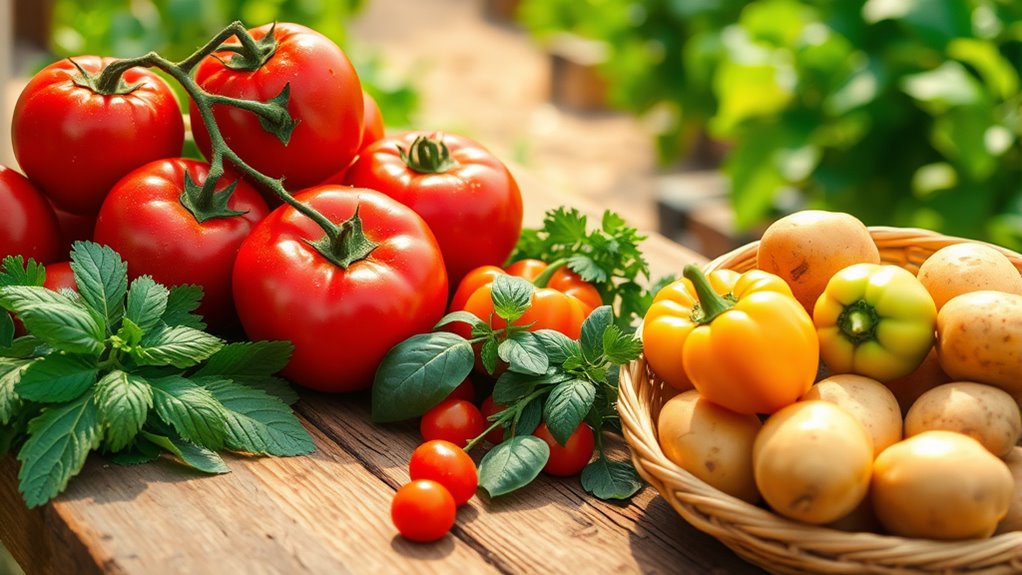To incorporate farm-to-table ingredients into your menus, focus on building direct relationships with local farmers and choosing seasonal, regional products. Highlight freshness by sourcing herbs, vegetables, and artisanal goods at their peak. Emphasize sustainable practices and tell the story behind your ingredients to attract diners. Balance cost and quality by diversifying suppliers and managing inventory carefully. Keep exploring strategies to create authentic, flavorful dishes that celebrate your community’s rich agricultural heritage.
Key Takeaways
- Source seasonal, regional ingredients directly from local farms to ensure freshness and flavor.
- Collaborate with farmers to plan menus around harvest schedules and sustainable practices.
- Highlight artisanal and ethically sourced products to enhance authenticity and support regional producers.
- Use menu descriptions to tell the story of farm origins, emphasizing freshness and community ties.
- Adapt menus based on ingredient availability and feedback to maintain quality and sustainability.
Understanding the Principles of Farm-to-Table Dining

Farm-to-table dining centers on the idea of sourcing ingredients directly from local farms to guarantee freshness and support the community. This approach emphasizes farm to table sustainability, ensuring that food is produced ethically and responsibly. By prioritizing ethical sourcing practices, you help reduce the carbon footprint associated with long-distance transportation and promote environmentally friendly farming methods. The core principle is to create a transparent supply chain that benefits local farmers and minimizes waste. When you choose farm-to-table ingredients, you’re embracing a system that values quality, freshness, and social responsibility. Incorporating local sourcing not only enhances the flavor and nutritional value of your dishes but also aligns your menu with sustainable and ethical food practices. Additionally, understanding the benefits of farm-to-table can help you make more informed decisions that support both your community and the environment. Implementing AI security solutions in sourcing and supply chain management can further optimize transparency and efficiency, ensuring that ethical standards are maintained throughout. Supporting small-scale farmers is another key aspect that promotes local economies and preserves traditional agricultural practices.
Building Relationships With Local Farmers and Producers
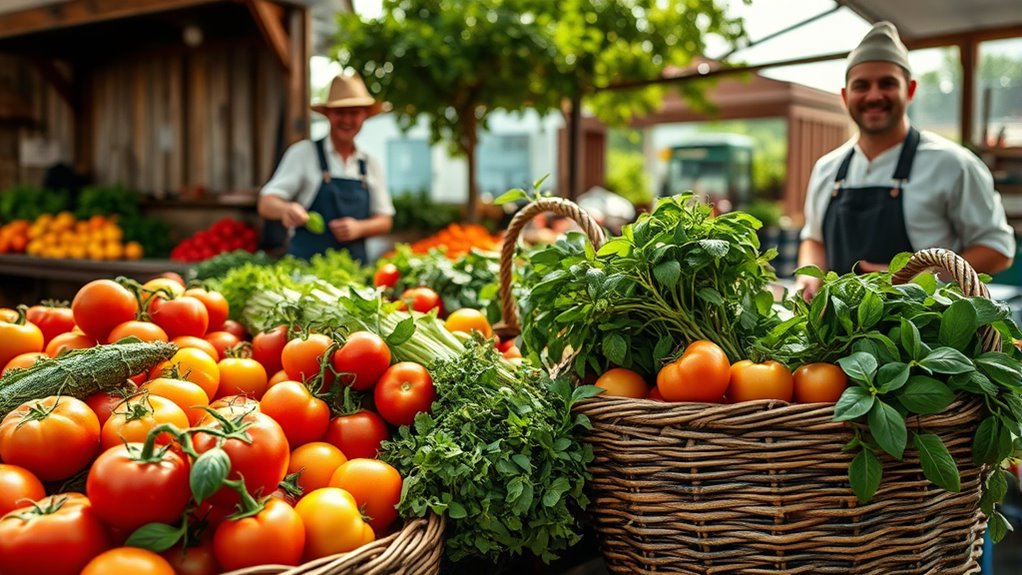
Building strong relationships with local farmers and producers is the foundation of a successful farm-to-table approach. Connecting directly with urban farmers and seasonal farming operations helps guarantee you get fresh, high-quality ingredients consistently. Visit farms regularly, ask about their growing methods, and understand their harvest schedules. This ongoing communication builds trust and allows you to plan menus around peak harvest times, supporting seasonal farming practices. Supporting local producers also fosters a sense of community and encourages sustainable agriculture. When you prioritize these relationships, you gain better insight into the origin of your ingredients, which translates into fresher, more flavorful dishes. Establishing genuine partnerships with local farmers ensures a reliable supply chain and emphasizes your commitment to farm-to-table principles. Direct farm engagement allows you to better understand their practices and adapt your menus accordingly. Additionally, understanding the harvest schedules enables you to align your menu planning with the availability of seasonal produce, ensuring maximum freshness and flavor.
Selecting Seasonal and Regional Ingredients
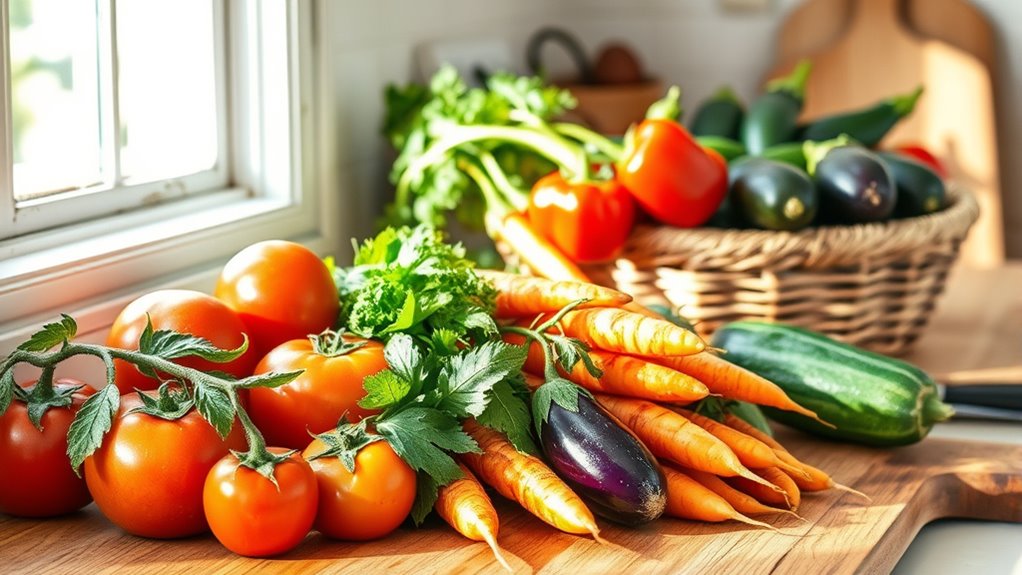
Choosing seasonal and regional ingredients guarantees your dishes highlight the freshest flavors available while supporting local agriculture. By focusing on farm diversity and crop rotation, you ensure a sustainable supply of ingredients throughout the year. This approach reduces reliance on long-distance transportation and minimizes environmental impact. When selecting ingredients, consider these key factors:
Embrace seasonal, regional ingredients to serve fresh flavors and support sustainable local farming practices year-round.
- Peak harvest times for regional crops
- Variety of farms practicing crop rotation
- Local markets and farm stands
- Seasonal availability charts
- Collaborating with farmers on planting schedules
- Incorporating AI-powered data analytics to forecast crop yields and optimize sourcing strategies. Utilizing specialized tuning techniques can also help farms improve crop performance and sustainability.
These strategies help you create dynamic menus that evolve with the seasons, promote sustainable farming practices, and offer your guests authentic, vibrant flavors rooted in your community.
Incorporating Fresh Herbs and Vegetables Into Your Menu
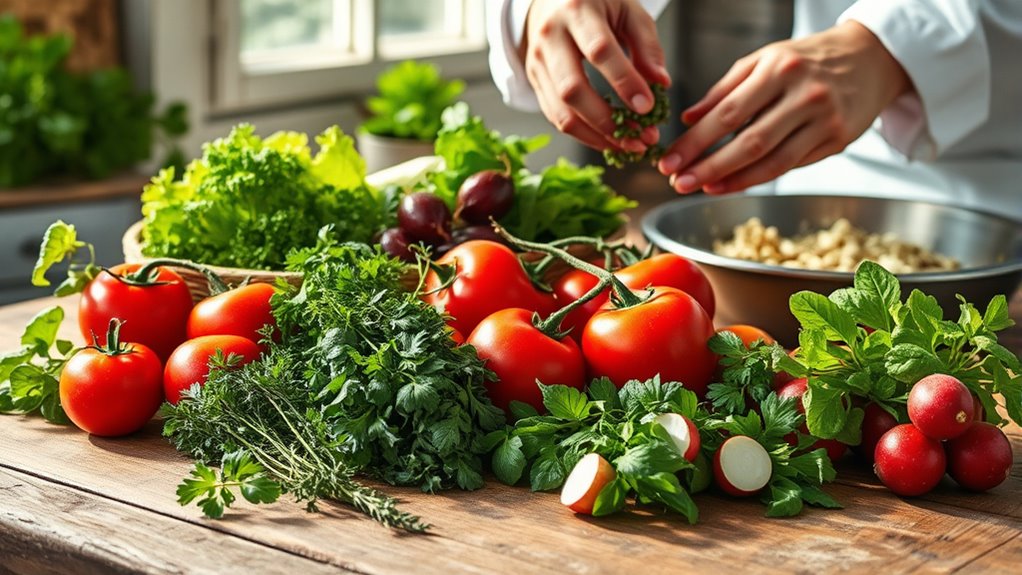
Incorporating fresh herbs and vegetables into your menu starts with choosing seasonal produce that highlights peak flavor. Experiment with creative herb pairings to add depth and brightness to your dishes. By focusing on these elements, you can elevate your menu with vibrant, farm-fresh ingredients. Incorporating local and sustainable sourcing practices can further enhance the quality and appeal of your offerings. Understanding the regional agricultural heritage can inspire menu choices that resonate with your community and support local farmers, ensuring your dishes reflect the richness of your area’s agricultural traditions. Emphasizing seasonal produce not only boosts flavor but also supports environmentally friendly farming practices. Additionally, exploring nearby water parks can provide inspiration for seasonal, family-friendly dishes that complement your farm-to-table approach.
Selecting Seasonal Produce
Selecting seasonal produce guarantees your menu features the freshest flavors at their peak. By focusing on ingredient freshness, you ensure your dishes highlight the best that each season offers. Incorporate seasonal menus that adapt throughout the year, appealing to customers seeking vibrant, flavorful options. When choosing produce, consider these tips:
- Visit local farmers’ markets for peak freshness and variety
- Prioritize items that are in-season to maximize flavor and affordability
- Look for produce with firm texture and vibrant color
- Avoid items with blemishes or signs of spoilage
- Plan your menu around what’s readily available and at its best
- Understanding the divorce process can inform how you plan menus during transitional periods in your restaurant’s staffing or ownership, ensuring smooth operations despite changes.
- Additionally, staying informed about market demand can help you select ingredients that are most likely to appeal to your customers and optimize your menu offerings. Recognizing shifts in consumer preferences can help you adapt your ingredient choices to meet evolving tastes and dietary trends.
- Incorporating seasonal herbs and vegetables can enhance the freshness and flavor of your dishes while supporting local growers and reducing your environmental footprint.
- Exploring innovative planter designs can also inspire ideas for sustainable sourcing and presentation of fresh ingredients in your restaurant’s decor and display.
Creative Herb Pairings
Fresh herbs and vegetables can transform a dish from ordinary to exceptional, adding vibrant flavors and aromatic complexity. Creative herb pairing enhances your menu by balancing and elevating each ingredient’s natural taste. Think beyond basics—combine basil with tomatoes for sweet freshness or dill with cucumber for a bright, tangy note. Experiment with flavor enhancement by mixing herbs that complement or contrast, creating layered depth. Use this table to inspire your pairings:
| Herb | Ideal Pairing |
|---|---|
| Basil | Tomatoes, mozzarella |
| Rosemary | Lamb, roasted vegetables |
| Mint | Peas, citrus dishes |
These pairings evoke emotion and excitement, making your dishes memorable and inviting. Trust your palate and let fresh herbs transform your farm-to-table offerings, embracing creative flavor combinations to excite your diners. Incorporating herb pairing techniques can further refine the harmony of your dishes and enhance overall flavor to elevate the dining experience.
Showcasing Artisanal and Ethically Sourced Products
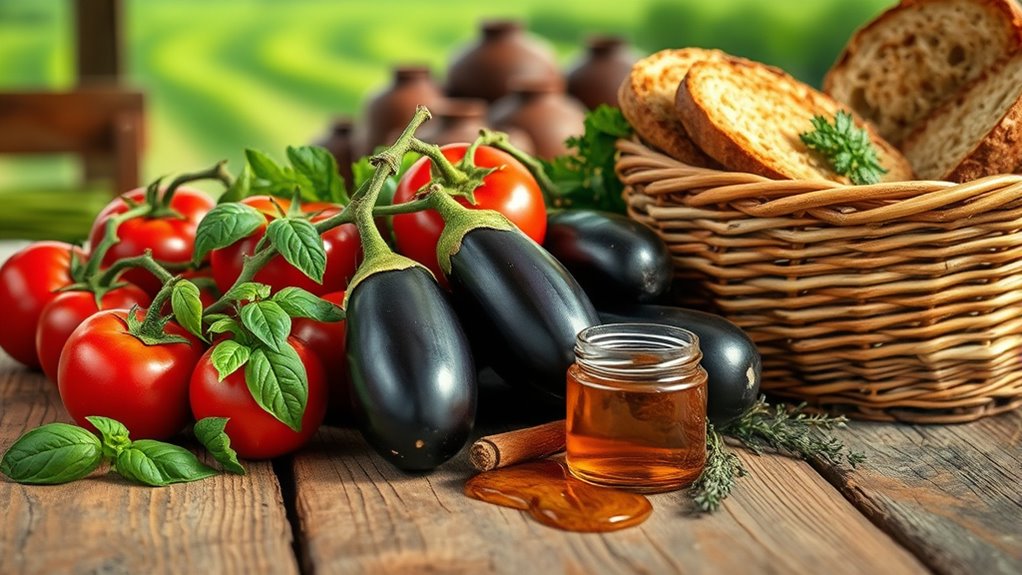
Showcasing artisanal and ethically sourced products allows you to highlight local artisans and their unique creations. By emphasizing sustainable practices, you can appeal to diners who care about the environment and community impact. Promoting these products also introduces your guests to bold, authentic flavors they can’t find elsewhere. Incorporating vetted products ensures safety and quality in your offerings, and understanding tea culture and traditions can inspire creative pairings that elevate the dining experience.
Highlighting Local Artisans
By focusing on local artisans, farm-to-table initiatives highlight the craftsmanship and ethical practices behind every product. You can celebrate regional talent and promote sustainability by sourcing directly from community artisans. Engage with practices like urban foraging, which uncovers wild ingredients right in your city, or collaborate with community supported agriculture programs to ensure freshness and support local economies. Highlighting these artisans connects diners to the story behind their food, emphasizing ethical sourcing and craftsmanship. Consider including:
- Unique handmade cheeses and cured meats
- Honey and preserves from local beekeepers
- Artisanal bread and baked goods
- Handcrafted condiments and sauces
- Ethically sourced seafood and meats
This approach elevates your menu and fosters community pride while offering authentic, ethically sourced options.
Emphasizing Sustainable Practices
Emphasizing sustainable practices is essential to creating a farm-to-table experience that truly supports the environment and local communities. You can incorporate urban foraging, which encourages sourcing ingredients from city environments, reducing food miles, and promoting resourcefulness. Highlighting farm sustainability means choosing suppliers committed to eco-friendly farming methods, such as crop rotation and minimal pesticide use. By prioritizing artisanal and ethically sourced products, you ensure that your menu reflects respect for the land and local producers. This approach not only reduces environmental impact but also strengthens community ties. When you emphasize sustainability, you demonstrate a commitment to responsible sourcing, inspiring your guests to appreciate the story behind their food while supporting practices that preserve our planet for future generations.
Promoting Unique Flavors
Have you ever noticed how artisanal and ethically sourced products can elevate a dish from ordinary to extraordinary? These ingredients introduce unique flavors that invite cultural fusion and spark flavor experimentation. By incorporating them, you create memorable dining experiences that stand out. Consider:
- Using locally crafted cheeses to add depth and authenticity
- Incorporating rare spices from different regions for cultural fusion
- Experimenting with small-batch preserves to enhance sweetness
- Pairing ethically sourced oils and vinegars for complex layers
- Highlighting traditional methods in preparation for a genuine touch
These products not only showcase craftsmanship but also tell a story, making your menu more engaging. Embracing artisanal and ethically sourced ingredients encourages culinary innovation and celebrates diverse flavors, giving your dishes a distinctive edge.
Designing Dishes That Highlight Ingredient Origin and Story

When crafting dishes that showcase ingredient origin and story, focus on presentation and storytelling to captivate diners. Use plating presentation to visually emphasize the ingredient’s journey, highlighting colors, shapes, and textures that reflect its farm origin. Pair wine thoughtfully to complement the dish’s story, enhancing the overall experience. Incorporate elements like herbs or edible flowers from the farm to deepen the narrative. Consider how each component tells a part of the story, engaging diners emotionally and gastronomically. Use this table to guide your approach:
| Aspect | Tip |
|---|---|
| Plating | Keep it simple; let ingredients speak visually. |
| Storytelling | Share origin details with diners for connection. |
| Pairing Wine | Match wine to highlight farm-fresh flavors. |
This approach makes the story of your ingredients memorable and appetizing.
Balancing Cost and Quality in Sourcing Local Ingredients
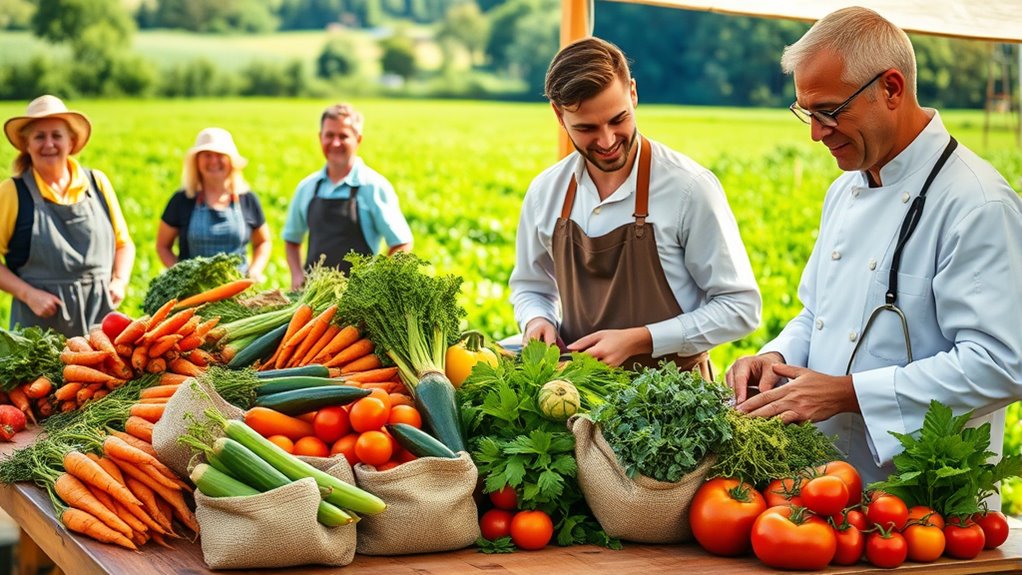
Balancing cost and quality when sourcing local ingredients is vital for your restaurant’s success. You need to find budget-friendly options that still guarantee freshness and flavor. Building strong relationships with local suppliers can help you access quality ingredients without sacrificing your budget.
Budget-Friendly Sourcing Options
Finding affordable ways to source local ingredients requires strategic planning and strong relationships with producers. Building connections helps you access quality produce without overspending. Consider working directly with farmers who use efficient farm equipment and prioritize soil management, which can reduce costs and improve yield. You can also:
- Join local co-ops to share resources and bulk-buy ingredients
- Support community-supported agriculture (CSA) programs for seasonal discounts
- Visit farmers’ markets for fresh, competitively priced produce
- Negotiate directly with growers for better prices
- Engage in farm exchanges or shared harvest agreements
Focusing on soil management practices can enhance soil health and crop quality, reducing the need for expensive inputs. Balancing cost and quality ensures you deliver fresh, flavorful dishes without breaking your budget.
Ensuring Ingredient Freshness
After establishing strong relationships with local producers and supporting community-supported agriculture, you can focus on maintaining ingredient freshness without overspending. Proper ingredient storage is key to preserving quality and extending shelf life. Use temperature-controlled environments like refrigeration and cool storage areas to keep perishable items fresh. Regularly check storage conditions and rotate stock to prevent spoilage. Implementing freshness preservation techniques—such as vacuum sealing or using breathable containers—can further maintain flavor and texture. Keep an organized storage system so you can easily monitor inventory and spot items nearing expiration. By prioritizing effective ingredient storage and freshness preservation methods, you ensure your menu features vibrant, high-quality ingredients while managing costs efficiently.
Building Local Supplier Relationships
Building strong relationships with local suppliers is essential for sourcing high-quality ingredients without overspending. When you connect directly with urban agriculture projects or farmers, you gain access to fresh, seasonal produce while supporting sustainability. These partnerships help you negotiate fair prices and reduce food waste by obtaining precisely what you need. Consider these strategies:
- Visit farms and urban agriculture sites regularly
- Attend local farmers’ markets and community events
- Collaborate on menu planning to match seasonal availability
- Share feedback to ensure consistent quality
- Emphasize transparency to foster trust and mutual growth
Marketing Farm-to-Table Offerings to Attract Customers
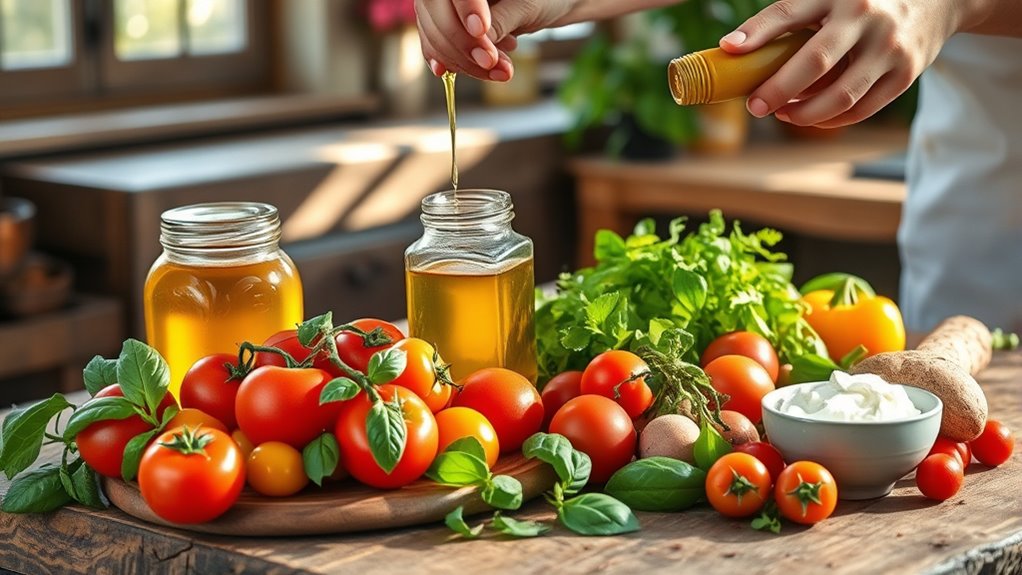
To effectively attract customers to farm-to-table offerings, you need to highlight the freshness and local origins of your ingredients through targeted marketing strategies. Focus on farm to table marketing by emphasizing the story behind each ingredient, sharing details about local sourcing strategies, and showcasing the farmers you partner with. Use your menu, social media, and signage to communicate the benefits of eating locally, such as supporting the community and enjoying peak freshness. Consider hosting farm-to-table events or farm visits to create a personal connection. By consistently promoting the local aspect of your ingredients, you build trust and appeal to customers seeking authentic, sustainable dining experiences. Clear messaging and authentic storytelling are key to making your farm-to-table offerings stand out.
Overcoming Challenges in Sourcing and Supply Chain Management

Sourcing fresh, local ingredients consistently can be challenging due to unpredictable factors like weather, seasonal variations, and supplier reliability. Transportation hurdles can delay deliveries or increase costs, making it harder to keep ingredients fresh. To overcome this, consider effective storage solutions to extend shelf life and reduce waste. Building strong relationships with local farmers helps ensure better communication and reliability. Diversifying suppliers minimizes risks if one source faces issues. Implementing just-in-time ordering reduces storage needs and ensures freshness. Additionally, investing in temperature-controlled storage preserves quality during transit and storage, maintaining ingredient integrity. By proactively addressing transportation hurdles and optimizing storage, you can maintain a steady supply of farm-to-table ingredients, ensuring your menu remains fresh and appealing to customers.
Evaluating and Evolving Your Farm-to-Table Menu Strategy
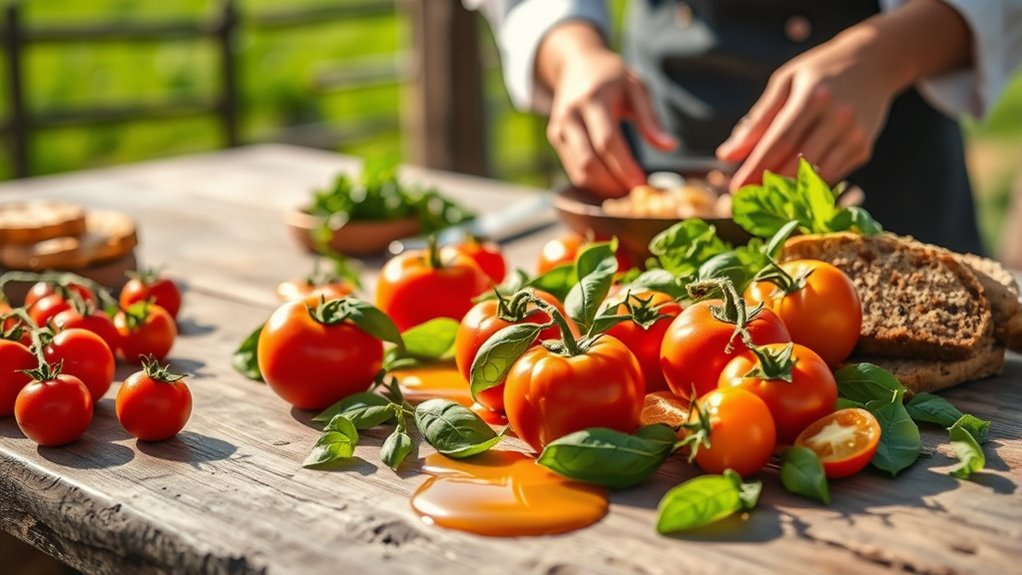
Regularly reviewing your farm-to-table menu guarantees it stays fresh, relevant, and aligned with seasonal availability. To avoid farm to table missteps, review customer feedback and track ingredient availability, adjusting dishes as needed. This helps prevent stagnation and ensures your offerings reflect current trends and local produce. Focus on menu diversification to appeal to a broader audience and showcase seasonal ingredients creatively. Evolving your strategy might involve introducing new dishes or rotating ingredients to keep the menu dynamic. Stay vigilant about sourcing challenges that could impact consistency. By continuously evaluating performance and staying adaptable, you’ll maintain a vibrant, authentic farm-to-table experience that satisfies customers and supports local producers. This proactive approach keeps your menu both innovative and sustainable.
Frequently Asked Questions
How Can Small Restaurants Effectively Implement Farm-To-Table Practices?
You can effectively implement farm-to-table practices by building strong farm partnerships, ensuring you get the freshest ingredients. Visit local farms regularly to establish trust and understand their harvesting schedules. Highlight ingredient freshness on your menu to attract customers. By maintaining open communication with farmers, you’ll receive quality products that elevate your dishes. This approach supports local producers and creates a unique, authentic dining experience for your guests.
What Are Common Legal Considerations When Sourcing Local Ingredients?
Legal considerations, like certification standards and legal compliance, often seem straightforward but are complex when sourcing local ingredients. You need to guarantee your suppliers meet food safety laws and labeling requirements, which can vary by region. While supporting local farms feels like a simple choice, you must navigate contracts, traceability, and potential liability issues, balancing ethical sourcing with legal obligations to keep your operation safe and compliant.
How Do Seasonal Changes Impact Menu Planning and Ingredient Availability?
Seasonal changes directly impact your menu planning by influencing the seasonal harvest and ingredient freshness. As seasons shift, certain ingredients become more abundant and flavorful, allowing you to highlight fresh, locally sourced items. You need to modify your menus accordingly, emphasizing what’s in peak season to ensure quality and taste. This approach not only enhances your dishes but also supports local farmers and reduces ingredient waste.
What Are Cost-Effective Ways to Maintain Quality With Local Sourcing?
Imagine chasing a squirrel with a shopping list—cost management and supplier relationships are your best tools. To save money while keeping quality, build strong local supplier relationships; they’ll often offer better deals and fresher ingredients. Negotiate for bulk discounts or seasonal pricing. Staying flexible with menu options helps you adapt to ingredient availability, ensuring you deliver farm-to-table goodness without breaking the bank. Your wallet—and your guests—will thank you!
How Can Chefs Educate Customers About Farm-To-Table Benefits?
You can boost customer engagement by sharing farm-to-table storytelling, highlighting the journey of ingredients from local farms to their plates. Educate your customers by explaining the benefits, like freshness and supporting local economies. Use menu descriptions, social media, and staff conversations to showcase these stories. This approach makes diners feel connected to their food, encouraging them to choose farm-to-table options and appreciate the quality and community impact behind each dish.
Conclusion
Just as the Renaissance transformed art and culture, embracing farm-to-table practices can revolutionize your menu and customer experience. By nurturing local relationships and prioritizing freshness, you’ll create dishes that resonate with authenticity and sustainability. Stay adaptable and committed to your farm-to-table vision, evolving with seasons and supply chains. Remember, the journey toward a truly authentic menu mirrors the odyssey of discovery—embrace it, and watch your culinary reputation flourish.
